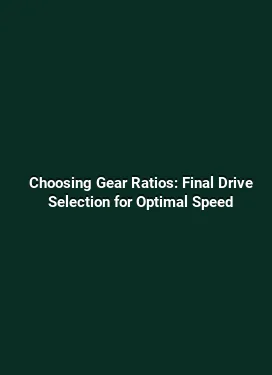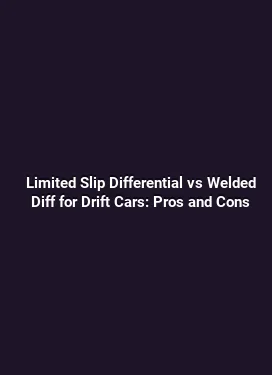Gear Ratio Calculator: Choosing the Best Final Drive for Your Setup
Understanding Gear Ratios, Final Drives, and Drivetrain Principles

In any vehicle, the interaction between engine speed, transmission gears, and the final drive determines how quickly power reaches the wheels. The final drive ratio specifically ties the transmission output to the wheels, influencing acceleration, top speed, engine RPM at cruising, and overall drivability. A gear ratio calculator helps visualize how changing the final drive, tire size, or transmission setup shifts these metrics, enabling deliberate tuning for a given objective—whether it is rapid off-the-line acceleration, relaxed highway cruising, or a balanced compromise.
Key concepts to grasp include engine torque, torque at the wheels, and RPM targets at different speeds. The final drive ratio is a single number that multiplies the torque from the transmission by a fixed amount before it reaches the driven wheels, while also reducing the speed of wheel rotation relative to engine rotation. Higher final drive ratios (e.g., 4.10, 4.56) increase low-end torque felt at the wheels, improving acceleration at the expense of higher engine RPM during cruising. Lower ratios (e.g., 2.73, 3.08) yield calmer engine speeds at highway speed and potentially better fuel economy but can compromise launch performance. Understanding these trade-offs is the first step in applying a gear ratio calculator to real-world setups.
How a Gear Ratio Calculator Works and What It Reveals
A gear ratio calculator models several interconnected variables to forecast vehicle performance metrics. At its core, it uses the final drive ratio, transmission gearing, tire diameter, and engine redline to compute the engine RPM at any target wheel speed. The calculator can also estimate acceleration times for given mass, estimate engine efficiency at different RPM ranges, and project the impact on fuel consumption. This analytical approach helps avoid guesswork when selecting a final drive for a specific goal, such as a drag-focused build or a daily driver that prioritizes both comfort and responsiveness.
Practical inputs include the wheel and tire diameter (accounting for the installed tire’s rolling radius), the current or planned gear ratios within the transmission, and the engine’s torque curve. It is often useful to incorporate tire load-bearing changes due to suspension setup, aero drag reductions, or weight distribution tweaks, all of which influence how a final drive performs in reality. A robust calculator incorporates these factors and presents results in intuitive formats such as RPM at various speeds, 0–60 mph or 0–100 km/h times (with a given powertrain), and estimated engine mileage across driving scenarios.
Key Variables and Their Impacts

Final drive ratio: This is the main lever for affecting wheel torque and RPM. A higher ratio amplifies torque at the wheels, which helps with quick launches but raises engine RPM at cruising speeds. A lower ratio reduces RPM at speed, improving fuel economy and reducing noise, but may require more gear changes or slower acceleration off the line.
Tire diameter: Larger tires effectively raise the overall gearing, even with a fixed final drive, because a larger circumference means the wheel travels farther per revolution. This shifts the engine RPM at a given road speed downward, potentially impacting acceleration and engine reaction time.
Transmission gear ratios: The spread and spacing of gears determine how often the engine operates in its optimal torque band. Wide gaps can force less-than-ideal engine speeds in certain gears, which a calculator can illustrate when paired with a final drive number.
Practical Guidelines for Selecting a Final Drive
Choosing a final drive is not solely about maximizing RPM or torque; it is about aligning the entire powertrain with the vehicle’s intended role. The following guidelines help translate calculator results into actionable decisions for different build philosophies.
For a track-focused build, prioritizing acceleration and high-r-loading grip often means selecting a slightly taller final drive (higher ratio) than stock to keep the engine in its usable torque band during short sprints. A street-performance setup might favor a balanced ratio that delivers responsive takeoffs while maintaining comfortable highway RPM. For fuel-efficiency-oriented daily driving, a lower (numerically higher) final drive can significantly reduce engine speed at highway velocity, cutting fuel consumption and engine wear over long distances.
Additionally, tire size adjustments must be considered together with the final drive. If you increase tire diameter to improve ride comfort or traction, you effectively raise the gearing, even if the final drive remains unchanged. The calculator helps quantify how this change shifts RPM at a given speed and whether the shift aligns with engine torque availability.
Case Studies: Real-World Scenarios and Solutions
Case study one examines a compact sport sedan used for daily commuting and occasional weekend laps. The factory final drive ratio sits at 3.65 with a tire diameter of 26 inches. The owner wants quicker takeoffs without sacrificing highway economy. By inputting a slightly taller final drive, such as 3.91 or 4.10, and keeping the stock tires, the calculator shows an appreciable lift in wheel torque at lower speeds and a moderate increase in engine RPM at highway speeds. The conclusion is to opt for a 4.10 ratio paired with a performance-oriented tire compound for optimal balance.
Case study two explores a lightweight rear-wheel-drive hot hatch used primarily on backroads and occasional track days. The gearbox presents a wide ratio spread with a relatively short top gear. A higher final drive ratio can improve start-off thrust and mid-range acceleration, but the trade-off is increased engine RPM during cruising. The calculator indicates a sweet spot around 3.73–3.90 depending on the engine’s torque peak and the desired top speed. The recommendation is to pair a 3.8 final drive with an appropriate tire size to maintain a usable torque band across gears.
Advanced Considerations: Performance, Efficiency, and Durability
Beyond simple torque amplification, several nuanced factors influence final drive choice. Drivetrain efficiency, gear lubrication, and differential type all contribute to real-world outcomes. Limited-slip differentials can reduce power loss due to wheel spin during aggressive launches, effectively improving traction and making the final drive choice more forgiving in slippery conditions. Conversely, open differentials may reveal pronounced torque steer or wheel slip that reduces measurable performance gains, particularly in high-torque engines.
Drivetrain losses, typically a few percent, matter more in high-performance builds. The gear ratio calculator should allow a loss-adjusted scenario to reflect real-world conditions, especially in vehicles with less-than-ideal weight distribution or aggressive aero profiles. Engine and transmission torque curves are also critical. Matching a final drive to the engine’s peak torque bandwidth ensures the most efficient and responsive acceleration without over-revving or lugging the engine.
Integrating Gear Ratios with Broader Performance Goals
Gear ratios do not exist in isolation. Their effectiveness depends on calibration with engine management, transmission shift logic, and overall vehicle weight distribution. For manual transmissions, a carefully selected final drive can reduce the need for frequent gear changes during spirited driving by keeping the engine within an optimal RPM window for a broader range of speeds. For automatics or dual-clutch setups, the torque-converter behavior or clutch engagement strategy can interact with gearing, subtly changing the practical feel of acceleration and response times.
In performance tuning, it is common to pair final drive adjustments with suspension tuning, gearing to compensate for drag reduction, and even aero enhancements. A holistic approach ensures the final drive choice complements the vehicle’s power output, traction characteristics, and intended usage, delivering consistent performance across varied driving scenarios.
Workflow: Using a Gear Ratio Calculator Effectively
To leverage a gear ratio calculator efficiently, start with a clear objective: whether it is faster 0–60 mph times, higher top speed, or improved fuel economy. Gather reliable inputs, including engine horsepower and torque at various RPM, current gear ratios, tire diameter, vehicle weight, and estimated aerodynamic drag. Input these into the calculator and explore the sensitivity of the results to different final drive ratios. Look for a configuration that keeps the engine within its efficient torque band for the primary driving scenario, minimizes revving at typical cruising speeds, and respects torque limits of the drivetrain components.
Validation with real-world data is essential. After selecting a target final drive, perform controlled measurements—measured acceleration times, observed engine RPM at cruising speeds, and, if possible, fuel efficiency across common routes. Iterate as needed, because practical results often reveal trade-offs not evident in initial estimates. A robust approach combines numerical insight from the calculator with empirical testing for confidence in the final configuration.
Conclusion-Free Real-World Takeaways
Choosing the best final drive involves balancing acceleration, driveability, and efficiency while accounting for tire size, transmission characteristics, and the engine’s torque profile. A gear ratio calculator translates these interdependencies into actionable insights, guiding decisions for street use, track days, or endurance driving. Through careful input of accurate data and scenario testing, owners can arrive at a final drive setup that aligns with their performance goals and daily needs, without compromising reliability or comfort.






